
Notre Dame students have always found the lakes prime summer recreation spots for swimming, boating, and fishing. The St. Joseph’s Boating Club organized on April 21, 1867, “for the physical, as well as the mental education of its members, both the art of Rowing and Sailing” [Annual Catalog for the Academic Year 1866-1867, page 21]. Rev. Auguste Lemonnier, CSC, nephew of Rev. Edward Sorin and University President 1872-1874, was director of the Club. When Lemonnier tragically died in 1874 at the age of 35, the Boating Club was renamed in his honor.
 Boating Club on the lake, c1867-1874.
Boating Club on the lake, c1867-1874.
Rev. Auguste Lemonnier, CSC, is at the far right.
Notre Dame garnered a number of boats in the second half of the 19th century, with such names as Nina (staff boat), Pinta, Santa Maria, Hiawatha, Minnehaha, Montmorency, Yosemite, Evangeline, and the Golden Jubilee and Silver Jubilee.
 Crew of the Silver Jubilee, 1896
Crew of the Silver Jubilee, 1896
Arthur Chase, Charles Neizer (Niezer), Edward Gilmartin, Jenaro Davila,
Captain John Mullen, Coxswain George McCarrick, Lucian Wheeler
The popularity of the Boating Club quickly made it necessary for the construction of a Boat House to store all of the equipment and provide for lounge space for the members of the Boating Club. While probably not the first, the Boat House which still exists today was built in 1873.
 Students around the Boat House on St. Joseph Lake, 1893
Students around the Boat House on St. Joseph Lake, 1893
The Boating Club would occasionally take trips up to Niles, Michigan, on the St. Joseph River. Crews raced at least twice a year on St. Joseph’s Lake — for the Feast of St. Edward and for Commencement.
 Freshman (Class of 1916, upper-left), Sophomore (Class of 1915, lower-right), Junior (Class of 1914, upper-right), and Senior (Class of 1913, lower-left) Class Crew teams who competed in the 1913 Commencement races. The Freshmen defeated the Sophomores, and the Juniors, with Knute Rockne on the team, defeated the Seniors.
Freshman (Class of 1916, upper-left), Sophomore (Class of 1915, lower-right), Junior (Class of 1914, upper-right), and Senior (Class of 1913, lower-left) Class Crew teams who competed in the 1913 Commencement races. The Freshmen defeated the Sophomores, and the Juniors, with Knute Rockne on the team, defeated the Seniors.
Competitive crews clubs at Notre Dame continue to exist today and Women’s Rowing became a varsity sport in 1996.
 Postcard of a boat rowing crew practice on St. Joseph’s Lake with Main Building and Sacred Heart Church Basilica in the background, c1910
Postcard of a boat rowing crew practice on St. Joseph’s Lake with Main Building and Sacred Heart Church Basilica in the background, c1910
 Women’s Varsity Crew team rowing on St. Mary’s Lake with the Main Building Dome, Hesburgh Library, and Basilica of the Sacred Heart in the background, 1999-2000
Women’s Varsity Crew team rowing on St. Mary’s Lake with the Main Building Dome, Hesburgh Library, and Basilica of the Sacred Heart in the background, 1999-2000
Sources:
Scholastic
Dome yearbook 1914
Annual Catalog for the Academic Year 1866-1867
GSBA 2/01
GMLS 7/04
GNDL 4/20
GNDS 28/34 (William Edward Cleaver Scrapbook)
GNDS 9/01 (Warren Baldwin Scrapbook)
GPHR 9/34
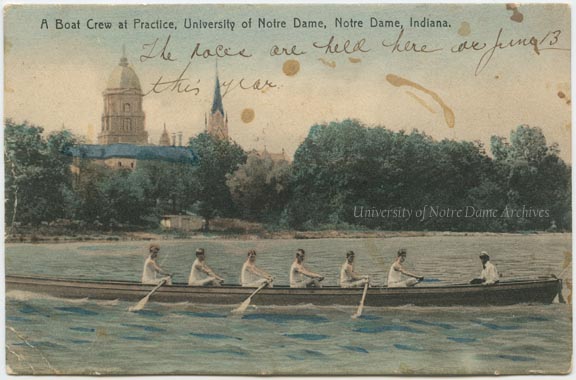
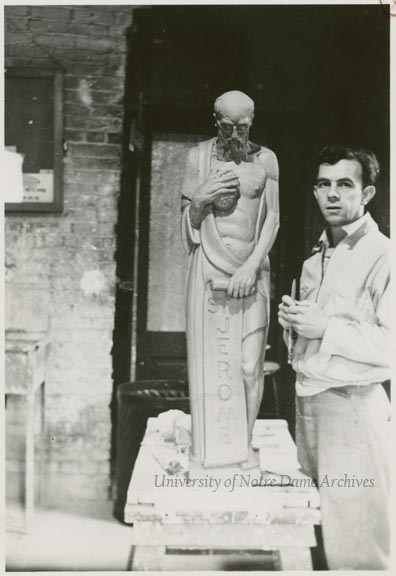






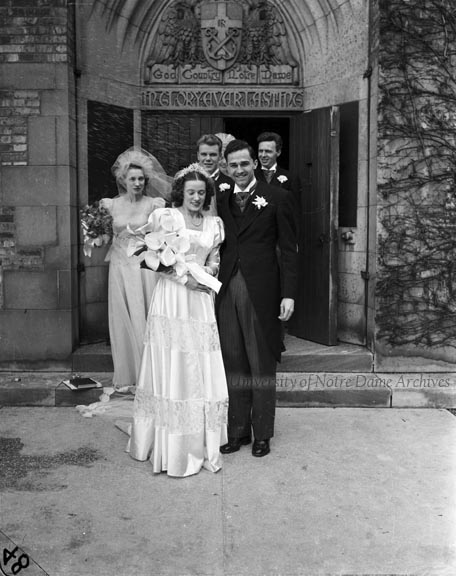
 A wedding party, c1860s-1870s
A wedding party, c1860s-1870s Newspaper illustration of the wedding of Minnie Sherman (daughter of General William Tecumseh Sherman) and Lieutenant Thomas Fitch, October 1, 1874, at St. Aloysius’ Church in Washington, D.C. (sketched by Harry Ogden). Among the numerous dignitaries in attendance were President and Mrs. Ulysses S. Grant; Rev. Edward Sorin, CSC, founder and president of the University of Notre Dame; and Mother Angela Gillespie, CSC, director of St. Mary’s Academy (now College), cousin of Ellen Ewing Sherman (wife of William Tecumseh Sherman), and namesake of Angela Boulevard in South Bend
Newspaper illustration of the wedding of Minnie Sherman (daughter of General William Tecumseh Sherman) and Lieutenant Thomas Fitch, October 1, 1874, at St. Aloysius’ Church in Washington, D.C. (sketched by Harry Ogden). Among the numerous dignitaries in attendance were President and Mrs. Ulysses S. Grant; Rev. Edward Sorin, CSC, founder and president of the University of Notre Dame; and Mother Angela Gillespie, CSC, director of St. Mary’s Academy (now College), cousin of Ellen Ewing Sherman (wife of William Tecumseh Sherman), and namesake of Angela Boulevard in South Bend Pages 42-43 from “My Wedding Day” booklet by Louis LaRovoire Morrow, Bishop of Krishnagar, 1949. These pages outline the vows of the ceremony and the blessing of the rings in English and Latin
Pages 42-43 from “My Wedding Day” booklet by Louis LaRovoire Morrow, Bishop of Krishnagar, 1949. These pages outline the vows of the ceremony and the blessing of the rings in English and Latin Pages from “Check List for Your Wedding” booklet by Msgr. James A. Magner, 1959. These pages outline what the bride, groom, parents, and attendants should wear to the ceremony. Gloves and hats are no longer required for Catholic weddings.
Pages from “Check List for Your Wedding” booklet by Msgr. James A. Magner, 1959. These pages outline what the bride, groom, parents, and attendants should wear to the ceremony. Gloves and hats are no longer required for Catholic weddings. A country wedding in Jamaica, c1890s
A country wedding in Jamaica, c1890s Portrait of a bride, c1890s
Portrait of a bride, c1890s A wedding party leaving the Basilica of the Sacred Heart while being pelted with rice, c1930s
A wedding party leaving the Basilica of the Sacred Heart while being pelted with rice, c1930s A bride with her father outside of the Basilica of the Sacred Heart, c1960
A bride with her father outside of the Basilica of the Sacred Heart, c1960 A wedding party, guests, and photographer at the Grotto, c1970s
A wedding party, guests, and photographer at the Grotto, c1970s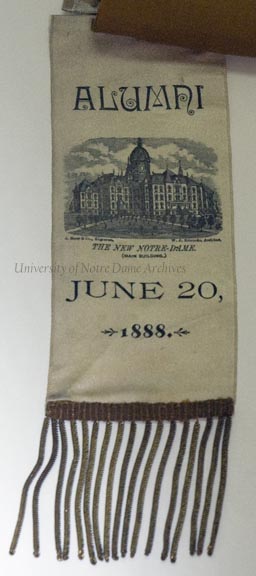








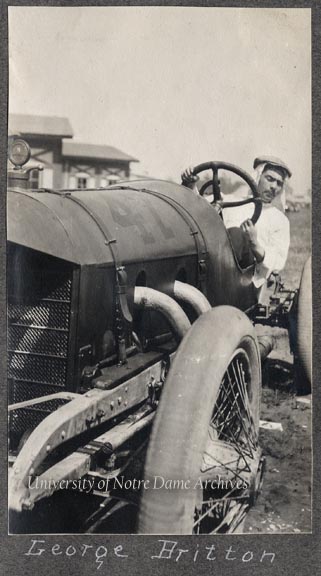











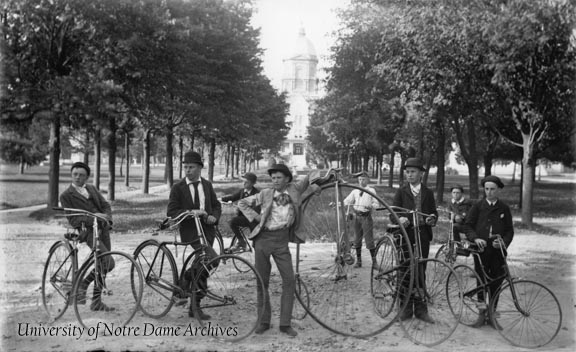




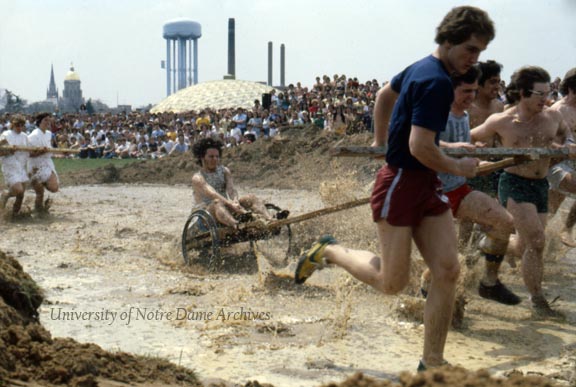







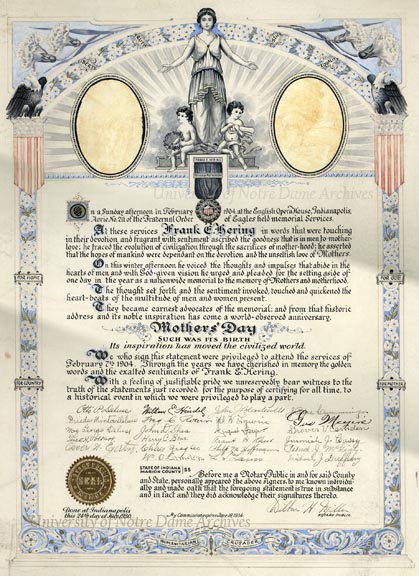


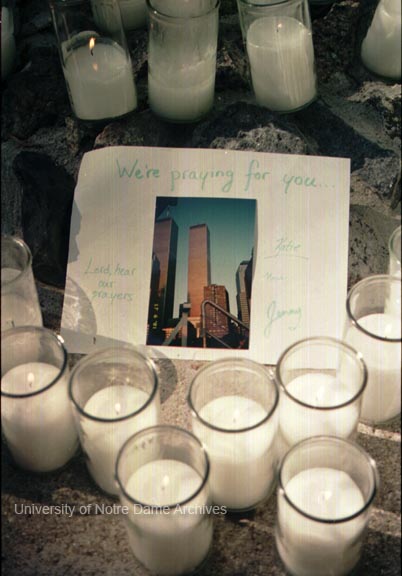



 Vigil Procession after the September 11, 2001, Terrorist Attacks
Vigil Procession after the September 11, 2001, Terrorist Attacks




